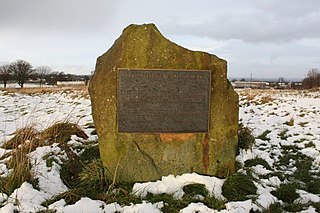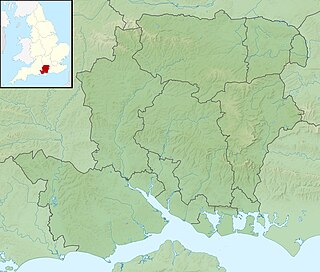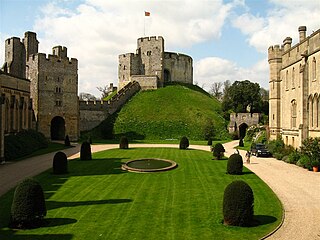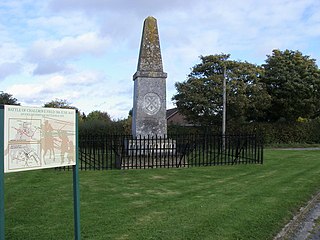 W
WThe Battle of Adwalton Moor occurred on 30 June 1643 at Adwalton, West Yorkshire, during the First English Civil War. In the battle, the Royalists loyal to King Charles led by the Earl of Newcastle soundly defeated the Parliamentarians commanded by Lord Fairfax.
 W
WThe Battle of Alton, of the First English Civil War, took place on 13 December 1643 in the town of Alton, Hampshire, England. There, Parliamentary forces serving under Sir William Waller led a successful surprise attack on a winter garrison of Royalist infantry and cavalry serving under the Earl of Crawford. The Battle of Alton was the first decisive defeat of Sir Ralph Hopton, leader of Royalist forces in the south, and the event had a significant psychological effect on him as commander. More important to Hopton was the loss of men, however, as he was already short-handed in much-needed infantry. The successful Parliamentarians were able, after their victory, to attack and successfully besiege Arundel, a larger and more formidable Royalist outpost to the south-east of Alton.
 W
WThe Siege of Arundel took place during the First English Civil War, from 19 December 1643 to 6 January 1644, when a Royalist garrison surrendered to a Parliamentarian army under William Waller.
 W
WThe Battle of Aldbourne Chase was a relatively small battle of the First English Civil War that occurred on 18 September 1643. In the skirmish the Royalist cavalry led by Prince Rupert attacked the extended columns of the Parliamentarian army of the Earl of Essex at Aldbourne Chase as he was attempting to get his army to London.
 W
WThe Battle of Clones occurred on 13 June 1643 during the Irish Confederate Wars when Irish Confederate forces commanded by Owen Roe O'Neill were decisively defeated at Clones, County Monaghan by the Protestant Laggan Army commanded by Sir Robert Stewart.
 W
WThe Battle of Rocroi, fought on 19 May 1643, was a major engagement of the Thirty Years' War. It was fought between a French army led by the 21-year-old Duke of Enghien and Spanish forces under General Francisco de Melo only five days after the accession of Louis XIV to the throne of France following his father's death. Rocroi is regarded as the graveyard of the myth of invincibility of the Spanish Tercios, the terrifying infantry units that had dominated European battlefields for 120 years up to that point. The battle is therefore often considered to mark the end of Spanish military greatness and the beginning of French hegemony in Europe. After Rocroi, the Spanish abandoned the Tercio system and adopted the Line infantry doctrine like the French.
 W
WThe Battle of Braddock Down was a battle of the south-western campaign of the First English Civil War. It was fought on open ground in Cornwall, on 19 January 1643. An apparently easy victory for the Royalists under Sir Ralph Hopton secured Cornwall for King Charles and confirmed Hopton's reputation as a commander. Hopton also gained respect for the mercy shown to his foe, of whom 1,500 were captured during and after the battle. The precise location of the battlefield is a matter of dispute, though English Heritage believe it to be within parkland at Boconnoc.
 W
WThe Battle of Bramber Bridge was a minor skirmish that took place on 13 December 1643, during the First English Civil War. A Royalist detachment from Arundel attempted to secure the bridge over the River Adur at Bramber in West Sussex, but found a Parliamentarian force already in possession.
 W
WThe Battle of Burton Bridge was fought between Royalist and Parliamentarian forces at Burton upon Trent on 4 July 1643 during the First English Civil War. By the time of the battle, the town, which had at various times been held by both sides, was garrisoned by a Parliamentarian unit under the command of Captain Thomas Sanders and the town's military governor, Colonel Richard Houghton. The key river crossing at Burton was desired by Queen Henrietta Maria, who was proceeding southwards from Yorkshire with a convoy of supplies destined for King Charles I at Oxford. The Royalists, led by Colonel Thomas Tyldesley, launched a cavalry charge across the bridge which succeeded in defeating the Parliamentarians and capturing most of their officers, including Sanders and Houghton. The Queen's convoy proceeded on its way south to Oxford with Tyldesley receiving a knighthood and a promotion in recognition of his victory. Burton changed hands several more times during the course of the war, before finally coming into Parliament's control in 1646.
 W
WThe Battle of Camp Hill took place on Easter Monday, 3 April 1643, in and around Camp Hill, during the First English Civil War. In the skirmish, a company of Parliamentarians from the Lichfield garrison with the support of some of the local townsmen, approximately 300 men, attempted to stop a detachment of 1,400 Royalists under the command of Prince Rupert from passing through the unfortified parliamentary town of Birmingham.
 W
WThe Battle of Chalgrove Field took place on 18 June 1643, during the First English Civil War, near Chalgrove, Oxfordshire. A relatively small scale battle, it is best remembered for the death of John Hampden, who died of wounds six days later.
 W
WThe Battle of Cloghleagh, Cloghlea, Cloughleagh, Cloughleigh also known as the Battle of Funcheon Ford or the Battle of Manning Water, was a battle fought between a Royalist force and an Irish Confederate force during the Irish Confederate Wars. It took place south of Kilworth and north of Fermoy between the river Funcheon and the river Blackwater in County Cork on 4 June 1643. The result was an Irish Confederate victory.
 W
WThe Battle of Gainsborough was a battle in the First English Civil War, fought on 28 July 1643. The strategically important town of Gainsborough was a Royalist base used for harassing the Parliamentarians who were generally dominant in Lincolnshire. An attempt to capture Gainsborough by Charles Cavendish and the Royalists was foiled in a battle in which Colonel Oliver Cromwell distinguished himself as a cavalry leader.
 W
WThe Battle of Heptonstall occurred in November 1643 during the First English Civil War at Hebden Bridge and Heptonstall, Yorkshire. During the battle, Colonel Bradshaw, a Parliamentarian commander fended off an attack by Sir Francis Mackworth and the Royalists.
 W
WThe Battle of Hopton Heath was a battle of the First English Civil War, fought on Sunday 19 March 1643 between Parliamentarian forces led by Sir John Gell, 1st Baronet and Sir William Brereton and a Royalist force under Spencer Compton, 2nd Earl of Northampton.
 W
WThe First English Civil War battle of Lansdowne was fought on 5 July 1643, near Bath, Somerset, southwest England. Although the Royalists under Lord Hopton forced the Parliamentarians under Sir William Waller to retreat from their hilltop position, they suffered so many casualties themselves and were left so disordered and short of ammunition that an injured Hopton was forced to retire.
 W
WThe First Battle of Newbury was a battle of the First English Civil War that was fought on 20 September 1643 between a Royalist army, under the personal command of King Charles, and a Parliamentarian force led by the Earl of Essex. Following a year of Royalist successes in which they took Banbury, Oxford and Reading without conflict before storming Bristol, the Parliamentarians were left without an effective army in the west of England. When Charles laid siege to Gloucester, Parliament was forced to muster a force under Essex with which to beat Charles' forces off. After a long march, Essex surprised the Royalists and forced them away from Gloucester before beginning a retreat to London. Charles rallied his forces and pursued Essex, overtaking the Parliamentarian army at Newbury and forcing them to march past the Royalist force to continue their retreat.
 W
WThe Battle of Olney Bridge was a skirmish that occurred on 4 November 1643 during the First English Civil War just outside the town of Olney, Buckinghamshire. In the engagement, Royalist forces attacked Parliamentarian forces holding the Olney bridge. The Parliamentarian forces held the bridge and the Royalists ultimately called off the attack.
 W
WThe Battle of Portlester took place on 7 August 1643 near the town of Ballivor, Leinster in Ireland as part of the Irish Confederate Wars. It was fought between the Ulster Army under Owen Roe O'Neill and a largely Protestant government force from Dublin under Lord Moore, with both sides proclaiming their basic loyalty to Charles I. In the battle the two armies exchanged artillery fire, during which Moore was killed and his army driven off, giving the Confederates victory.
 W
WThe Battle of Ripple Field, fought on 13 April 1643, was an engagement in the First English Civil War. In the battle, a Royalist calvalry force led by Prince Maurice routed Parliamentarian cavalry and infantry forces led by Sir William Waller.
 W
WThe Battle of Roundway Down was fought on 13 July 1643 near Devizes, Wiltshire, during the First English Civil War. A Royalist cavalry force under Lord Wilmot won a crushing victory over the Parliamentarians under Sir William Waller.
 W
WThe Battle of Seacroft Moor took place in Whinmoor moor near the village of Seacroft, north-east of Leeds in West Riding on 30 March 1643 during the First English Civil War. In the battle, a Parliamentarian force commanded by Lieutenant-General Thomas Fairfax was decisively beaten by a Royalist cavalry force commanded by George Goring.
 W
WThe Second Battle of Middlewich was a battle of the First English Civil War that took place on 26 December 1643 in Cheshire County. In the battle, Lord Byron and the Royalists defeated a Parliamentarian army commanded by Sir William Brereton.
 W
WThe Siege of Gloucester took place between 10 August and 5 September 1643 during the First English Civil War. It was part of a Royalist campaign led by King Charles I to take control of the Severn Valley from the Parliamentarians. Following the costly storming of Bristol on 26 July, Charles invested Gloucester in the hope that a show of force would prompt it to surrender quickly and without bloodshed. When the city, under the governorship of Lieutenant-Colonel Edward Massey, refused, the Royalists attempted to bombard it into submission. Massey adopted an aggressive defence, and the Royalist positions outside the city were regularly disrupted by Parliamentarian raids. The Royalist artillery proved inadequate for the task of siege work and, faced with a shortage of ammunition, the besiegers attempted to breach the city walls by mining. With Royalist miners about to reach the city's east gate and the defenders critically low on gunpowder, a Parliamentarian army led by the Earl of Essex arrived and forced Charles to lift the siege.
 W
WThe unsuccessful second Siege of Hull by the Royalist Earl of Newcastle in 1643 was a victory for Parliament at the high point of the Royalist campaign in the First English Civil War. It led to the abandonment of the Earl of Newcastle's campaign in Lincolnshire and the re-establishment of Parliament's presence in Yorkshire.
 W
WThe Siege of Lichfield occurred on 8–21 April 1643 during the First English Civil War. During the military action, the Royalists under the command of Prince Rupert successfully besieged the Parliamentary garrison of Lichfield in Staffordshire under the command of Colonel Russell.
 W
WThe Siege of Plymouth took place during the First English Civil War, when Royalist forces besieged Plymouth, in Devon, held by a Parliamentary garrison.
 W
WThe Siege of Reading was an eleven-day blockade of Reading, Berkshire during the First English Civil War. Reading had been garrisoned by the Royalists in November 1642, and held 3,300 soldiers under the command of Sir Arthur Aston. On 14 April 1643, Robert Devereux, 3rd Earl of Essex brought a Parliamentarian army of 19,000 men to lay siege to the town, and began bombarding the town two days later.
 W
WWardour Castle in Wiltshire was besieged twice during the First English Civil War; once in May 1643, and then again between November 1643 and March 1644. During the first siege, a Parliamentarian force of around 1,300 men led by Sir Edward Hungerford attacked the castle, which was the home of Thomas Arundell, 2nd Baron Arundell of Wardour, a prominent Catholic and Royalist. Arundell was absent, fighting for King Charles at the time of the attack, and the defence was led by his wife, Lady Blanche Arundell, in command of 25 soldiers. The siege was started on 2 May, and lasted for a week before the Parliamentarians forced Lady Arundell to surrender on 8 May. The Parliamentarians garrisoned the castle with 75 men, led by Colonel Edmund Ludlow.
 W
WThe short siege of Worcester was conducted by a Parliamentary army of about 3,000 under the command of Sir William Waller. They failed to capture the city, which was defended by about 1,700 Royalists under the command of Colonel William Sandys the acting governor, and retreated back to the Parliamentary stronghold of Gloucester.
 W
WThe Battle of Sourton Down was a successful Parliamentarian ambush at Sourton Down, in South West England, on 25 April 1643, during the First English Civil War. After a failed attack on Royalist-held Launceston, the Parliamentarians fell back on their base at Okehampton, pursued by a Royalist army under Sir Ralph Hopton, who marched overnight, planning to attack the town at dawn.
 W
WThe Storming of Bristol took place on 26 July 1643, during the First English Civil War. The Royalist army under Prince Rupert captured the important port of Bristol from its weakened Parliamentarian garrison. The city remained under Royalist control until the second siege of Bristol in September of 1645.
 W
WThe Battle of Stratton, also known as the Battle of Stamford Hill, took place on 16 May 1643, during the First English Civil War. In the battle, the Royalists destroyed Parliament's field army in Devon and Cornwall.
 W
WThe Torstenson war, Hannibal controversy or Hannibal War was a short period of conflict between Sweden and Denmark–Norway from 1643 to 1645 towards the end of the Thirty Years' War. The names refer to Swedish general Lennart Torstenson and Norwegian governor-general Hannibal Sehested.
 W
WThe Battle of Tuttlingen was fought in Tuttlingen on 24 November 1643. Those involved in the conflict were the French forces led by Marshal Josias Rantzau and the armies of the Holy Roman Empire and Spain led by Franz von Mercy. Technically, Mercy led a military force composed of Imperial, Spanish, Bavarian, and Lorrainer troops.
 W
WThe Capture of Wakefield occurred during the First English Civil War when a Parliamentarian force attacked the Royalist garrison of Wakefield, Yorkshire. The Parliamentarians were outnumbered, having around 1,500 men under the command of Sir Thomas Fairfax, compared to the 3,000 led by George Goring in Wakefield, but successfully stormed the town, taking roughly 1,400 prisoners.
 W
WThe Battle of Winceby took place on 11 October 1643 during the First English Civil War near the village of Winceby, Lincolnshire. In the battle, a Royalist relieving force under the command of Sir William Widdrington was defeated by the Parliamentarian cavalry of the Earl of Manchester.